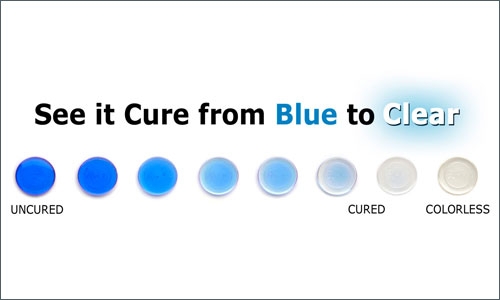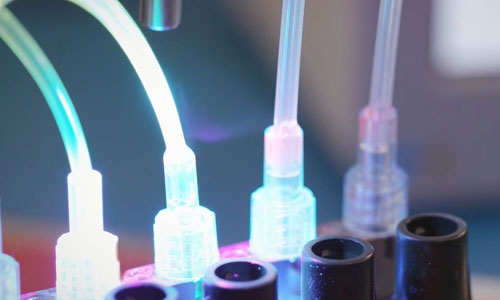粘合剂释气
问:我需要推荐一种医用级无细胞毒性用于…的UV胶粘剂将透明聚苯乙烯模制品粘接在一起。您会推荐哪种粘合剂?有什么简单但有效的方法来监测固化反应是否已完成?是否有任何剂量计可以准确测量紫外线照射?UV固化后的后烘烤是否有帮助?紫外线医用级丙烯酸酯在固化过程中是否会“排气”?
一个:在寻找医用级光固化胶粘剂时,有两个选择:Dymax 1201-M-SC和 1120-M-UR . 这些材料对聚苯乙烯表现出优异的粘附性,并且均通过了 ISO 10993/USP VI 级测试。
1201-M-SC 产品中采用了一种简单但有效的方法来监测固化是否完成。这种材料使用一种称为见效快,材料开始时是亮蓝色,固化后变为无色。这是一种极好的视觉指示,表明粘合线的所有部分都已完全固化。确定固化状态的其他方法包括对组件进行破坏性测试以测量拉力,或在粘合线表面滴一滴粘合剂,并使用此液滴测量粘性/半固化(通过观察粘合剂是否转移到戴手套的手指上来判断是否通过)。更复杂的方法包括对粘合剂进行显微镜 FTIR 分析,以确定固化前双键峰(在光谱上)的存在,以及固化后双键峰的消除。
剂量计对于准确测量光照是必不可少的,并且有不同版本,带有不同的传感器,可以测量紫外线和可见光光谱的各个部分。虽然大多数光固化胶粘剂都是通过 UV-A、UV-B、UV-C 和可见光的组合进行固化的,但参考来自光源的 UV-A 光谱通常很方便。UV-A 通常称为 365 nm,但覆盖范围约为 320-395 nm。这可以用 ACCU-CAL™ 50辐射计。如果聚苯乙烯具有防紫外线功能,那么你就必须依靠灯的可见光光谱。 ACCU-CAL™ 50V测量 395-465 nm。两种装置都可以提供平均强度2 )、峰值强度和总能量(焦耳/厘米2 )。其他选项包括 ACCU-CAL™ 50 LED ,它是为特殊灯具(例如,仅发射 365 nm、385 nm 或 405 nm 单一波长的 LED 灯)开发的,以围绕灯光谱的中心进行集成。
大多数粘合剂无需进行后烘烤,但有些粘合剂含有过氧化物热引发剂,可以利用热量来固化无法见光的区域。
关于固化过程中 UV 光固化胶粘剂的排气问题,有时可以观察到在固化步骤中胶粘剂表面会产生少量烟雾。这是很常见的情况,因为当光照射到胶粘剂上并发生固化时,胶粘剂可能会释放出配方中所含某些成分(或成分的一部分)的痕量。有时可以通过改变固化强度和持续时间以及胶粘剂选择和光源来克服这个问题。当胶粘剂用在两个表面之间时,不会发生这种情况。适当的通风有助于去除烟雾。如果烟雾沉积在聚光灯或泛光灯上,则应定期清洁光导或灯罩的末端,以去除可能在那里形成的薄膜,因为这种薄膜会降低粘合线处的强度。


